Chair exercises offer seniors a safe way to stay active while protecting joints. You’ll benefit from gentle seated movements like marching in place, arm circles, and heel raises that improve circulation, balance, and strength. Seated rebounding (gentle bouncing movements) adds cardiovascular benefits without stressing your body. Start with 20-30 minute sessions 3 times weekly, always beginning with proper warm-ups. The right technique transforms simple chair exercises into powerful fitness tools for your golden years.
Why Seated Rebounding Exercises Benefit Seniors
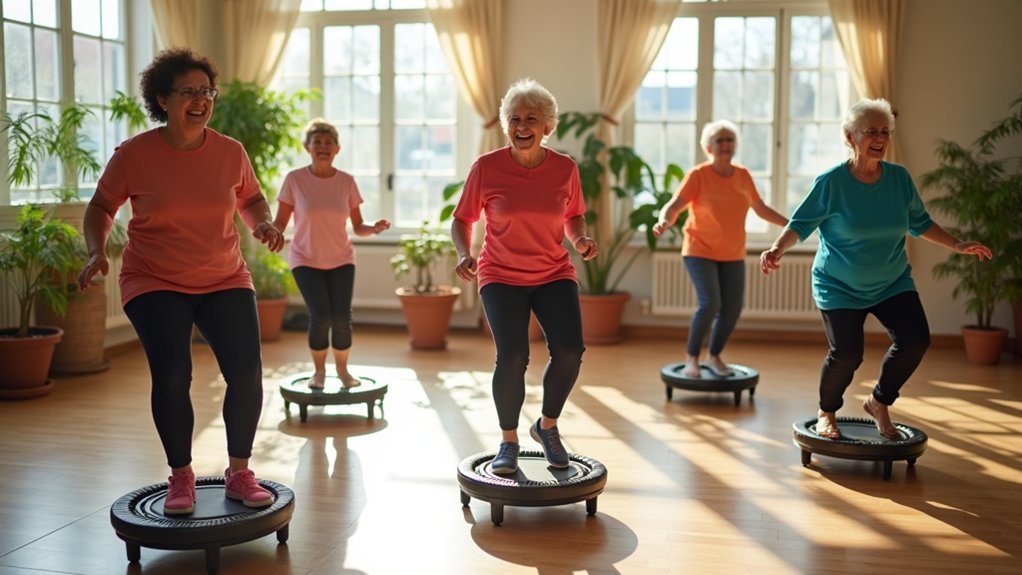
As we age, finding exercises that are both effective and gentle on the body becomes increasingly important. Seated rebounding offers a perfect solution, providing cardiovascular benefits without stressing your joints.
You’ll experience improved bone density, which helps combat osteoporosis risk, while the gentle bouncing motion enhances your balance and coordination. This considerably reduces your fall risk—a common concern for many seniors.
The controlled environment of chair rebounding eliminates fear of falling, making it accessible even if you have mobility challenges. Regular practice can lead to improved vitality and mental clarity, helping seniors maintain their independence longer.
You’ll notice improved muscle tone, especially in your lower limbs, which translates to better stability during daily activities.
Best of all, rebounding improves circulation and lymphatic drainage, reducing inflammation while boosting cognitive function through increased blood flow to the brain.
Five Essential Chair-Based Rebounding Movements for Older Adults
These five chair-based rebounding movements form the foundation of an effective seated exercise routine for seniors.
Start with the Seated Bounce, keeping feet flat on the floor while creating a gentle up-down rhythm that engages your core without stressing joints.
The gentle up-down rhythm of a Seated Bounce activates core muscles while protecting joints—perfect for seniors beginning their fitness journey.
Next, try Marching in Place by alternating knee lifts at a controlled tempo to strengthen hip flexors and improve coordination.
Heel Raises activate calf muscles through ankle flexion while enhancing mobility and circulation. Maintaining tall posture during this exercise maximizes its effectiveness while preventing slouching.
Incorporate Lateral Weight Shifts with side-to-side movements that engage obliques and improve balance without overextension.
Finally, add Arm Circles to improve shoulder mobility while maintaining proper seated posture.
You can adjust intensity for each movement by modifying pace, range of motion, or adding breath synchronization as you progress.
Safety Guidelines for Senior Rebounding Workouts
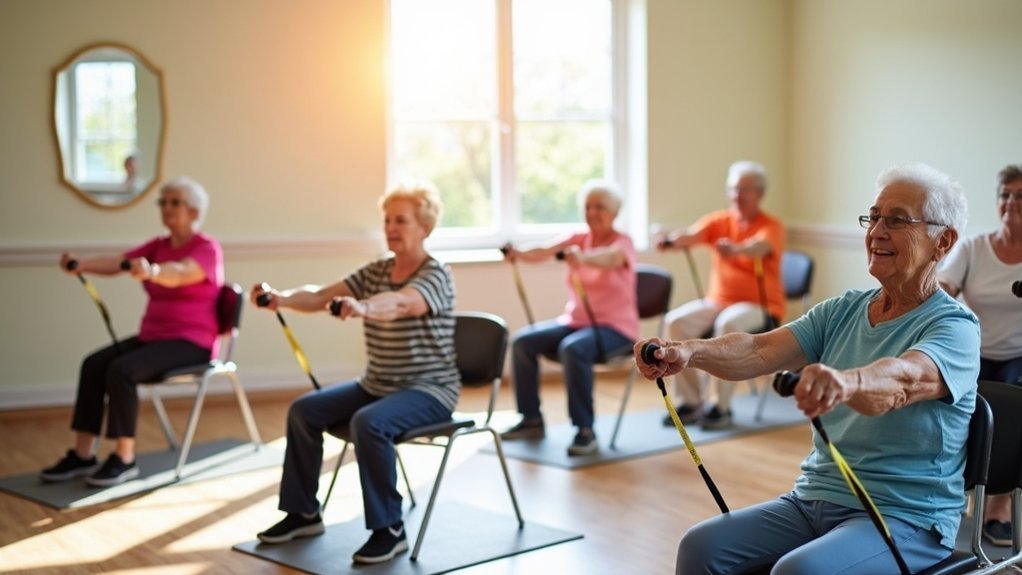
Safety should always be your top priority when engaging in rebounding exercises, especially for seniors with varying physical capabilities. Before starting, place your rebounder on a flat surface with 3-5 feet of clearance and position a sturdy chair nearby for support. Always warm up for 5-10 minutes, stretching your hips, calves, and hamstrings. This gentle exercise can significantly improve bone density and strength, which is particularly beneficial for seniors concerned about osteoporosis.
| Safety Phase | Key Action | Why It Matters |
|---|---|---|
| Pre-Workout | Consult physician | Addresses pre-existing conditions |
| Setup | Verify assembly | Prevents equipment failure |
| Movement | Begin with 1-2 inch bounces | Builds stability gradually |
| During Exercise | Keep torso aligned | Prevents harmful twisting |
| Post-Workout | Monitor for pain | Catches potential injuries early |
Don’t exceed 15-minute sessions initially, and incorporate 48-hour rest periods between workouts to guarantee proper recovery.
Adapting Rebounding Exercises for Different Mobility Levels
Rebounding exercises offer incredible flexibility for seniors with varying mobility limitations.
If you’re wheelchair-bound (Level 1), focus on seated balance drills using chair arms for support and gentle torso rotations while gripping the rebounder frame. Incorporating gentle ankle rotations while seated helps maintain lower body flexibility even with limited mobility.
For walker users (Level 2), try standing partial rebounds with 1-2 inch movements through your heels while maintaining grip on your walker.
Those who need walking aids but can stand independently (Level 3) can perform peripheral hold rebounds or low-impact jogging with minimal vertical displacement.
If you have balance concerns but move independently (Level 4), maintain hand contact with a wall during low-amplitude bouncing and use rhythmic pacing to regulate movement.
Seniors with full weight-bearing capability (Level 5) can challenge themselves with interlimb coordination exercises and gentle plyometric progressions.
Incorporating Chair Rebounding Into a Weekly Fitness Routine
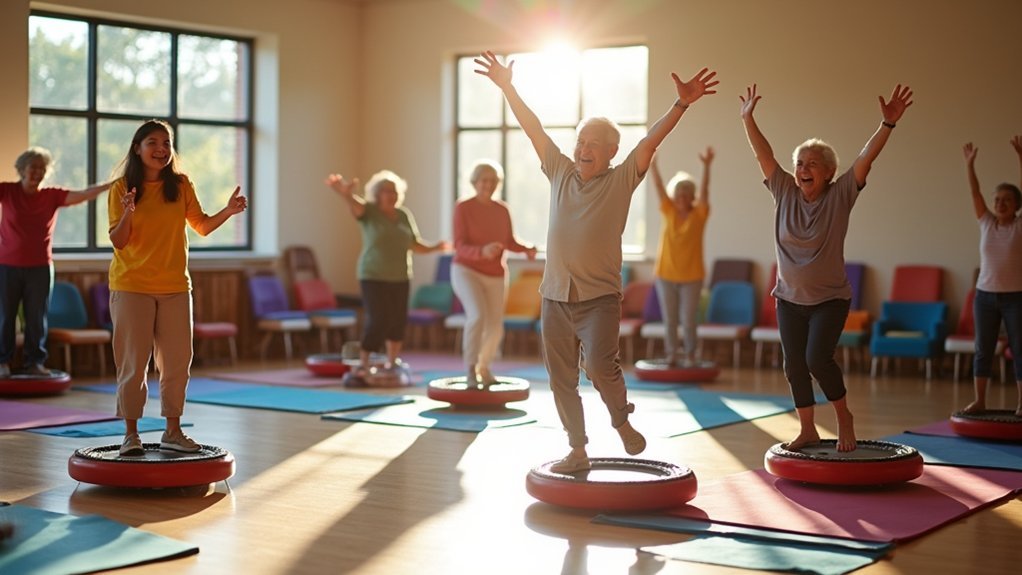
Structuring your weekly fitness routine with chair rebounding exercises can greatly enhance mobility and well-being for seniors across all ability levels. Aim for 3-5 sessions weekly, each lasting 20-30 minutes, to improve balance and reduce fall risk.
Regular chair rebounding workouts boost senior mobility and balance while reducing fall risk in just 20-30 minutes, 3-5 times weekly.
Alternate your rebounding days to allow proper muscle recovery while maintaining consistent movement. Begin each session with gentle warm-ups like seated marches or leg lifts, then progress to your main exercises combining bouncing, arm movements, and balance work.
As your coordination improves, gradually increase the intensity by extending your bounce duration or adding gentle height variations. This modified approach provides low-impact exercise options that are gentler on joints while still delivering significant health benefits.
Remember to incorporate hydration breaks and finish with appropriate cool-down stretches. This progressive approach guarantees safety while maximizing the cardiovascular, lymphatic, and bone-strengthening benefits of chair rebounding.
Frequently Asked Questions
How Do Chair Exercises Compare to Water Aerobics for Seniors?
You’ll find chair exercises offer better accessibility with minimal equipment, while water aerobics provides superior joint pain relief. Both are low-impact, but chairs offer more stability if you’re concerned about falls.
Can Chair Exercises Help With Arthritis Pain Management?
Yes, chair exercises can markedly help with your arthritis pain. You’ll experience reduced joint stiffness, decreased pain interference, and improved mobility. They’re specially designed to maintain joint health while being gentle on your body.
What Qualifications Should a Senior Chair Exercise Instructor Have?
You’ll want a senior chair exercise instructor with a primary group fitness certification, senior fitness specialist credentials, CPR/AED training, and experience in arthritis adaptations, fall prevention, and chair-based modifications for mobility limitations.
How Long Before Seniors Typically See Results From Chair Exercises?
You’ll likely notice improved balance and coordination in 2-4 weeks with consistent practice. Functional gains like easier sit-to-stand movements appear within 6-8 weeks, while strength improvements develop gradually with 2-3 weekly sessions.
Are Chair Exercises Appropriate for Seniors With Cognitive Impairments?
Yes, you’ll find chair exercises highly appropriate for seniors with cognitive impairments. They provide stability, can be adapted to various abilities, and offer cognitive stimulation through movement patterns and social interaction during group sessions.
In Summary
When you’re ready for a gentle, effective workout that’s kind to your joints, chair rebounding is your perfect companion. You’ll boost circulation, strengthen muscles, and improve balance all while seated safely. Start with just 5-10 minutes and gradually build up. Remember to listen to your body, stay hydrated, and celebrate each small improvement. You’re nurturing your health with every gentle bounce!

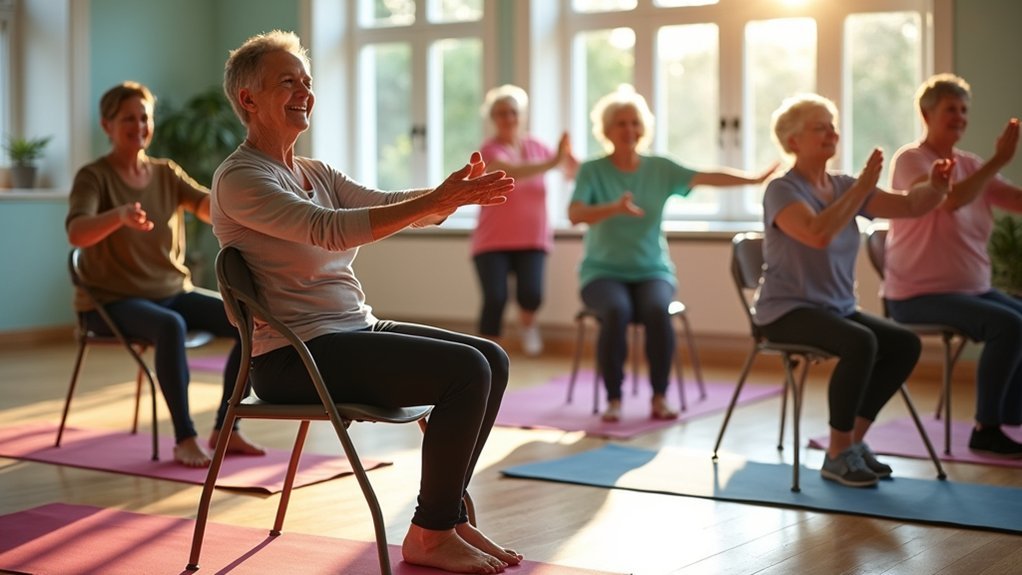
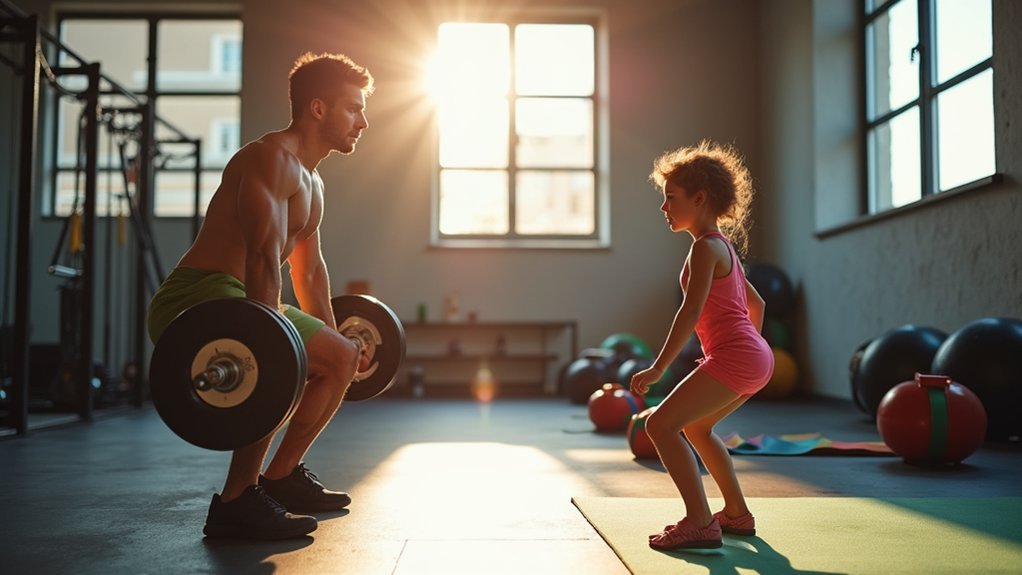


Leave a Reply